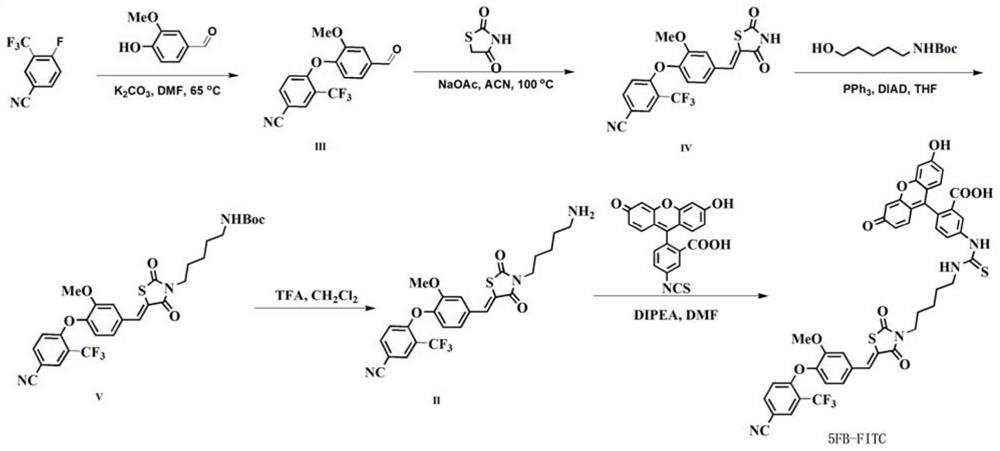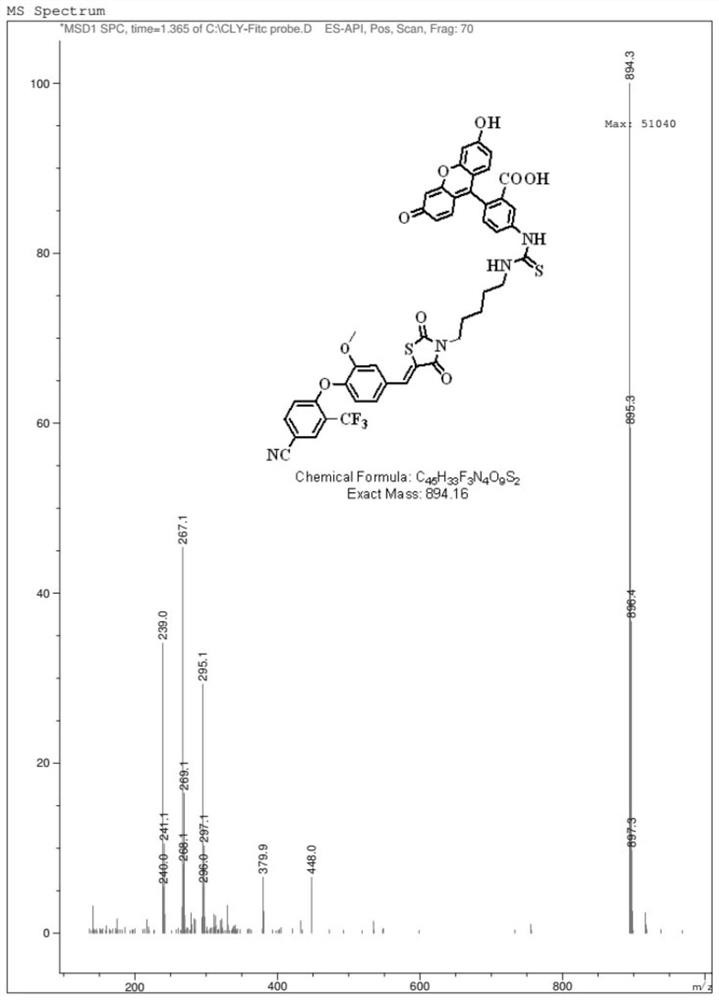Fluorescent probe compound and its preparation method and application
A fluorescent probe and compound technology, applied in the field of biological analysis, can solve the problems of cumbersome ligand operations and low accuracy, and achieve the effects of clear binding sites, convenient and fast detection, and good stability
- Summary
- Abstract
- Description
- Claims
- Application Information
AI Technical Summary
Problems solved by technology
Method used
Image
Examples
preparation example Construction
[0063] A second aspect of the present invention provides a method for preparing a fluorescent probe compound represented by formula (I), comprising the following steps:
[0064] In the presence of the reaction solvent I and the catalyst I, the compound represented by the formula (II) and the organic fluorescent molecule having the reactivity with the amino group are reacted I,
[0065]
[0066] According to the present invention, the compound represented by the formula (II) can provide a ligand with specific interaction with the ERRα protein, and different organic fluorescent molecules with reactivity with amino groups can be selected according to the application requirements to interact with the compound represented by the formula (II). The compounds shown form the corresponding fluorescent probe compounds.
[0067] Preferably, the organic fluorescent molecules having reactivity with amino groups are selected from:
[0068] one of the.
[0069] In the present inventi...
preparation example 1
[0104] (1) Dissolve 1 g of 4-fluoro-3-(trifluoromethyl)benzonitrile and 0.8 g of 4-hydroxy-3-methoxybenzaldehyde in 10 mL of dimethylformamide (DMF), and then add 2.2 g's K 2 CO 3 , heated to 65°C overnight to obtain reaction solution I, which was diluted with 1 mL of ice water, and then extracted three times with 10 mL of ethyl acetate. The liquid is acetic acid / n-hexane, and the volume ratio is 1:10) to obtain the compound shown in the formula (III) of 1.4g pale yellow;
[0105] (2) 1.3 g of the compound represented by the formula (III), 515 mg of 2,4-thiazolidinedione and 3.3 g of sodium acetate (NaOAc) were added to 20 mL of acetonitrile (ACN), and the temperature was 100°C The reaction was carried out for 24 h to obtain reaction solution II, and the organic phase of reaction solution II was spin-dried, and then purified by silica gel column chromatography (the eluent was acetic acid / n-hexane, and the volume ratio was 1:2) to obtain 857 mg of yellow solid, which was the ...
preparation example 2
[0109] (1) 0.8 g of 4-fluoro-3-(trifluoromethyl)benzonitrile and 0.7 g of 4-hydroxy-3-methoxybenzaldehyde were dissolved in 10 mL of dimethylformamide, and then 1.8 g of Na 2 CO 3 , heated to 60°C overnight to obtain reaction solution I, which was diluted with 1 mL of ice water, and then extracted three times with 10 mL of ethyl acetate. The liquid is acetic acid / n-hexane, and the volume ratio is 1:10) to obtain the compound shown in the pale yellow formula (III);
[0110] (2) 1 g of the compound represented by the formula (III), 0.4 g of 2,4-thiazolidinedione and 2.4 g of potassium acetate were added to 20 mL of acetonitrile, and reacted for 30 h at a temperature of 80 °C to obtain a reaction solution II, the organic phase of the reaction solution II is spin-dried, and then purified by silica gel column chromatography (the eluent is acetic acid / n-hexane, the volume ratio is 1:2) to obtain a yellow solid, which is the compound shown in formula (IV) ;
[0111] (3) Dissolve ...
PUM
 Login to View More
Login to View More Abstract
Description
Claims
Application Information
 Login to View More
Login to View More - R&D
- Intellectual Property
- Life Sciences
- Materials
- Tech Scout
- Unparalleled Data Quality
- Higher Quality Content
- 60% Fewer Hallucinations
Browse by: Latest US Patents, China's latest patents, Technical Efficacy Thesaurus, Application Domain, Technology Topic, Popular Technical Reports.
© 2025 PatSnap. All rights reserved.Legal|Privacy policy|Modern Slavery Act Transparency Statement|Sitemap|About US| Contact US: help@patsnap.com



